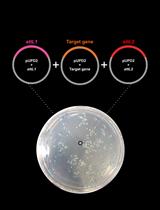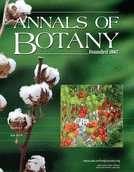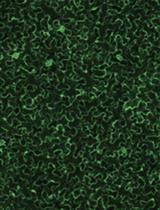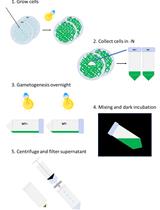- EN - English
- CN - 中文
TUNEL Assay in Kiwifruit Stigmatic Arms
奇异果柱头臂的TUNEL检测
发布: 2015年04月05日第5卷第7期 DOI: 10.21769/BioProtoc.1434 浏览次数: 11831
评审: Arsalan DaudiKanika GeraAnonymous reviewer(s)

相关实验方案

使用Brick into the Gateway (BiG) 实验方法快速克隆细菌基因
Flaviani G. Pierdoná [...] Fabio T. S. Nogueira
2022年12月20日 2296 阅读
Abstract
Terminal deoxynucleotidyl transferase-mediated dUTP nick end labelling (TUNEL) is a method for detecting DNA fragmentation by labelling the 3' terminal end of nucleic acids. This method can be used both in animal and plant tissues. In animal tissues, the use of Proteinase K is sufficient for permeabilizing the cells and to obtain optimal labelling, but in plant tissues, the presence of the cell wall, does not allow proper labelling. For this reason, we carried out several modifications to the original TUNEL protocol (ApoAlert® DNA Fragmentation Assay Kit, Clontech) to obtain an optimal labelling. These modifications were additional treatments with cellulase, Triton X-100 and Proteinase K. Also, we describe the optimization of the positive controls by adjusting the units of DNase used. The PI concentration for counterstaining has been also specifically adjusted to avoid excessive background noise and hence to correctly observe both labeled and unlabelled nuclei. This work also describes an additional protocol to collect, store and include samples (specifically stigmatic arms) in such a way that they do not interfere with the TUNEL labelling.
Keywords: Programmed Cell Death (具有细胞死亡)Materials and Reagents
- Acetic acid (CH3COOH) (Panreac Applichem)
- Acetone [(CH3)2CO] (Panreac Applichem)
- ApoAlert® DNA Fragmentation Assay Kit (Clontech, catalog number: 630107 )
- (3-Aminopropyl) triethoxy-silane (APTES) (C9H23NO3Si) (Sigma-Aldrich, catalog number: 440140 )
- Cellulase Onozuka RS (Duchefa Biochemie, catalog number: C8003 )
- Citifluor Solid Mountant kit (Agar Scientific, catalog number: AGR1326 )
- Clear nail polish
- Deionized H2O (Milli-Q H2O)
- Distilled water
- Disodium hydrogen phosphate (Na2HPO4) (Duchefa Biochemie)
- Ethylenediaminetetraacetic acid (EDTA) (C10H16N2O8) (Duchefa Biochemie)
- Ethanol (C2H5OH) (Panreac Applichem)
- Formaldehyde (HCHO) (36.5-38%) (Panreac Applichem, catalog number: 48 131328 )
- Monobasic potassium phosphate (KH2PO4) (Duchefa Biochemie)
- Paraffin (Panreac Applichem, catalog number: 253211 )
- Paraformaldehyde [(HCHO)n] (Panreac Applichem, catalog number: 141451 )
- Potassium chloride (KCl) (Duchefa Biochemie)
- Propidium iodide (PI) (Sigma-Aldrich, catalog number: P4864 )
- Proteinase K (Sigma-Aldrich, catalog number: P4850 )
- Recombinant DNase I (RNase-free) (TAKARA BIO, catalog number: 2270A )
- Sodium chloride (NaCl) (Duchefa Biochemie)
- Sodium hydroxide (NaOH) (Panreac Applichem)
- Sulfuric acid (H2SO4) (Sigma-Aldrich)
- Tertiary butyl alcohol/2-Methyl-2-Propanol (TBA) [(CH3)3COH] (Panreac Applichem, catalog number: 141903 )
- Tris (hydroxymethyl) aminomethane hydrochloride (Tris-HCl) [NH2C(CH2OH)3·HCl] (Duchefa Biochemie)
- Triton X-100 (Sigma-Aldrich)
- Xylene [C6H4(CH3)2] (Panreac Applichem)
- Fixing solution (see Recipes)
- TBA solutions (see Recipes)
- TBA:paraffin (see Recipes)
- Formulated water (see Recipes)
- APTES-coated slides (see Recipes)
- 1x PBS buffer (see Recipes)
- 4% formaldehyde in 1x PBS buffer (see Recipes)
- 2% Cellulase Onozuka in 1x PBS buffer (see Recipes)
- 0.5% Triton X-100 in 1x PBS buffer (see Recipes)
- Tris-HCl (see Recipes)
- EDTA (see Recipes)
- 100 mM Tris-HCl (see Recipes)
- Proteinase K solution (see Recipes)
- 1x DNase I buffer (see Recipes)
- 1,500 U/ml DNase I (see Recipes)
- PI solution (see Recipes)
- Anti-Fade reagent (see Recipes)
Equipment
- 15 ml tubes
- 100 ml darkened bottles
- 100 ml darkened glass bottles
- 100 ml glass flasks
- 200 ml glass Coplin jars
- 250 ml glass jars
- Autoclave
- Filters sterile Filtropur S 0.2 (SARSTEDT AG)
- Flat surface (wall tile)
- Forceps
- Fume hood
- Glass coverslips
- Glass-covered trays
- Laboratory oven
- Leica TCS-SP2 confocal microscope
- Leuckart's bars for paraffin block preparation (ICT, SL., catalog number: 101 20996051645 )
- Magnetic stirrer with heating plate
- Microtome (Shibuya optical)
- Microtome Blades Accu-Edge® low-profile (Sakura)
- Paint brush
- pH-meter
- Scalpel with sterile blades
- Slides
Software
- LCS Software for Leica TCS-SP2 confocal microscope
Procedure
文章信息
版权信息
© 2015 The Authors; exclusive licensee Bio-protocol LLC.
如何引用
Ferradás, Y., López, M., Testillano, P., Rey, M. and González, M. V. (2015). TUNEL Assay in Kiwifruit Stigmatic Arms. Bio-protocol 5(7): e1434. DOI: 10.21769/BioProtoc.1434.
分类
植物科学 > 植物分子生物学 > DNA > DNA 修饰
分子生物学 > DNA > DNA 标记
细胞生物学 > 细胞成像 > 固定细胞成像
您对这篇实验方法有问题吗?
在此处发布您的问题,我们将邀请本文作者来回答。同时,我们会将您的问题发布到Bio-protocol Exchange,以便寻求社区成员的帮助。
Share
Bluesky
X
Copy link













